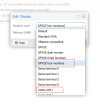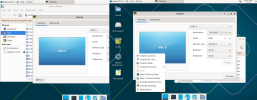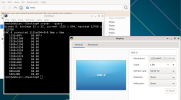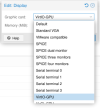Right now I am runing a server without a graphic card yet I can use lightdm/xfce4
I am going to refer to wiki of proxmox itself to show how useless these explanations are:
As the memory is reserved by display device, selecting Multi-Monitor mode for SPICE (such as qxl2 for dual monitors) has some implications:
> Linux VMs, can always enable more virtual monitors, but selectinga Multi-Monitor mode multiplies the memory given to the device withthe number of monitors.
Now let's see the difference in output between qxl4 and the default one i am using (virtio-gpu)

qxl4:
```
lspci
00:00.0 Host bridge: Intel Corporation 440FX - 82441FX PMC [Natoma] (rev 02)
00:01.0 ISA bridge: Intel Corporation 82371SB PIIX3 ISA [Natoma/Triton II]
00:01.1 IDE interface: Intel Corporation 82371SB PIIX3 IDE [Natoma/Triton II]
00:01.2 USB controller: Intel Corporation 82371SB PIIX3 USB [Natoma/Triton II] (rev 01)
00:01.3 Bridge: Intel Corporation 82371AB/EB/MB PIIX4 ACPI (rev 03)
00:02.0 VGA compatible controller: Red Hat, Inc. QXL paravirtual graphic card (rev 05)
00:03.0 Unclassified device [00ff]: Red Hat, Inc. Virtio memory balloon
00:05.0 PCI bridge: Red Hat, Inc. QEMU PCI-PCI bridge
00:08.0 Communication controller: Red Hat, Inc. Virtio console
00:09.0 Communication controller: Red Hat, Inc. Virtio console
00:12.0 Ethernet controller: Red Hat, Inc. Virtio network device
00:1e.0 PCI bridge: Red Hat, Inc. QEMU PCI-PCI bridge
00:1f.0 PCI bridge: Red Hat, Inc. QEMU PCI-PCI bridge
01:01.0 SCSI storage controller: Red Hat, Inc. Virtio SCSI
03:0c.0 Audio device: Intel Corporation 82801I (ICH9 Family) HD Audio Controller (rev 03)
root@debian:~/Desktop# xrandr --listmonitors
Monitors: 1
0: +Virtual-1 1920/508x1080/286+0+0 Virtual-1
```
and virtio
```
lspci
00:00.0 Host bridge: Intel Corporation 440FX - 82441FX PMC [Natoma] (rev 02)
00:01.0 ISA bridge: Intel Corporation 82371SB PIIX3 ISA [Natoma/Triton II]
00:01.1 IDE interface: Intel Corporation 82371SB PIIX3 IDE [Natoma/Triton II]
00:01.2 USB controller: Intel Corporation 82371SB PIIX3 USB [Natoma/Triton II] (rev 01)
00:01.3 Bridge: Intel Corporation 82371AB/EB/MB PIIX4 ACPI (rev 03)
00:02.0 VGA compatible controller: Red Hat, Inc. Virtio 1.0 GPU (rev 01)
00:03.0 Unclassified device [00ff]: Red Hat, Inc. Virtio memory balloon
00:05.0 PCI bridge: Red Hat, Inc. QEMU PCI-PCI bridge
00:08.0 Communication controller: Red Hat, Inc. Virtio console
00:09.0 Communication controller: Red Hat, Inc. Virtio console
00:12.0 Ethernet controller: Red Hat, Inc. Virtio network device
00:1e.0 PCI bridge: Red Hat, Inc. QEMU PCI-PCI bridge
00:1f.0 PCI bridge: Red Hat, Inc. QEMU PCI-PCI bridge
01:01.0 SCSI storage controller: Red Hat, Inc. Virtio SCSI
03:0c.0 Audio device: Intel Corporation 82801I (ICH9 Family) HD Audio Controller (rev 03)
root@debian:~/Desktop# xrandr --listmonitors
Monitors: 1
0: +Virtual-1 1920/325x1080/203+0+0 Virtual-1
```
so the question
how does one add extra virtual monitor/screen whatever in linux environment if there's only one exposed vga interface? this question has never been answered on this forum, i checked every topic that mentions virtual screens for linux mentions, I don't need to connect to the vm right away, i just need it at least to get displayed in xrandr
I am going to refer to wiki of proxmox itself to show how useless these explanations are:
Display
QEMU can virtualize a few types of VGA hardware. Some examples are:- std, the default, emulates a card with Bochs VBE extensions.
- cirrus, this was once the default, it emulates a very old hardware module with all its problems. This display type should only be used if really necessary [10], for example, if using Windows XP or earlier
- vmware, is a VMWare SVGA-II compatible adapter.
- qxl, is the QXL paravirtualized graphics card. Selecting this also enables SPICE (a remote viewer protocol) for the VM.
- virtio-gl, often named VirGL is a virtual 3D GPU for use inside VMs that can offload workloads to the host GPU without requiring special (expensive) models and drivers and neither binding the host GPU completely, allowing reuse between multiple guests and or the host.
VirGL support needs some extra libraries that aren’t installed by default due to being relatively big and also not available as open source for all GPU models/vendors. For most setups you’ll just need to do: apt install libgl1 libegl1
As the memory is reserved by display device, selecting Multi-Monitor mode for SPICE (such as qxl2 for dual monitors) has some implications:
- Windows needs a device for each monitor, so if your ostype is some version of Windows, Proxmox VE gives the VM an extra device per monitor. Each device gets the specified amount of memory.
- Linux VMs, can always enable more virtual monitors, but selecting a Multi-Monitor mode multiplies the memory given to the device with the number of monitors.
> Linux VMs, can always enable more virtual monitors, but selectinga Multi-Monitor mode multiplies the memory given to the device withthe number of monitors.
Now let's see the difference in output between qxl4 and the default one i am using (virtio-gpu)

qxl4:
```
lspci
00:00.0 Host bridge: Intel Corporation 440FX - 82441FX PMC [Natoma] (rev 02)
00:01.0 ISA bridge: Intel Corporation 82371SB PIIX3 ISA [Natoma/Triton II]
00:01.1 IDE interface: Intel Corporation 82371SB PIIX3 IDE [Natoma/Triton II]
00:01.2 USB controller: Intel Corporation 82371SB PIIX3 USB [Natoma/Triton II] (rev 01)
00:01.3 Bridge: Intel Corporation 82371AB/EB/MB PIIX4 ACPI (rev 03)
00:02.0 VGA compatible controller: Red Hat, Inc. QXL paravirtual graphic card (rev 05)
00:03.0 Unclassified device [00ff]: Red Hat, Inc. Virtio memory balloon
00:05.0 PCI bridge: Red Hat, Inc. QEMU PCI-PCI bridge
00:08.0 Communication controller: Red Hat, Inc. Virtio console
00:09.0 Communication controller: Red Hat, Inc. Virtio console
00:12.0 Ethernet controller: Red Hat, Inc. Virtio network device
00:1e.0 PCI bridge: Red Hat, Inc. QEMU PCI-PCI bridge
00:1f.0 PCI bridge: Red Hat, Inc. QEMU PCI-PCI bridge
01:01.0 SCSI storage controller: Red Hat, Inc. Virtio SCSI
03:0c.0 Audio device: Intel Corporation 82801I (ICH9 Family) HD Audio Controller (rev 03)
root@debian:~/Desktop# xrandr --listmonitors
Monitors: 1
0: +Virtual-1 1920/508x1080/286+0+0 Virtual-1
```
and virtio
```
lspci
00:00.0 Host bridge: Intel Corporation 440FX - 82441FX PMC [Natoma] (rev 02)
00:01.0 ISA bridge: Intel Corporation 82371SB PIIX3 ISA [Natoma/Triton II]
00:01.1 IDE interface: Intel Corporation 82371SB PIIX3 IDE [Natoma/Triton II]
00:01.2 USB controller: Intel Corporation 82371SB PIIX3 USB [Natoma/Triton II] (rev 01)
00:01.3 Bridge: Intel Corporation 82371AB/EB/MB PIIX4 ACPI (rev 03)
00:02.0 VGA compatible controller: Red Hat, Inc. Virtio 1.0 GPU (rev 01)
00:03.0 Unclassified device [00ff]: Red Hat, Inc. Virtio memory balloon
00:05.0 PCI bridge: Red Hat, Inc. QEMU PCI-PCI bridge
00:08.0 Communication controller: Red Hat, Inc. Virtio console
00:09.0 Communication controller: Red Hat, Inc. Virtio console
00:12.0 Ethernet controller: Red Hat, Inc. Virtio network device
00:1e.0 PCI bridge: Red Hat, Inc. QEMU PCI-PCI bridge
00:1f.0 PCI bridge: Red Hat, Inc. QEMU PCI-PCI bridge
01:01.0 SCSI storage controller: Red Hat, Inc. Virtio SCSI
03:0c.0 Audio device: Intel Corporation 82801I (ICH9 Family) HD Audio Controller (rev 03)
root@debian:~/Desktop# xrandr --listmonitors
Monitors: 1
0: +Virtual-1 1920/325x1080/203+0+0 Virtual-1
```
so the question
how does one add extra virtual monitor/screen whatever in linux environment if there's only one exposed vga interface? this question has never been answered on this forum, i checked every topic that mentions virtual screens for linux mentions, I don't need to connect to the vm right away, i just need it at least to get displayed in xrandr





